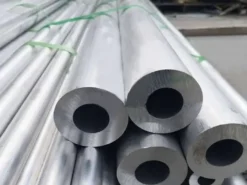product description
The use of 316 stainless steel plates has become more widespread with the development of the economy, and people are closely related to stainless steel in their daily lives. However, many people do not have much understanding of the performance of stainless steel, and they know less about the maintenance and upkeep of 316 stainless steel plates. Many people think that stainless steel will never rust, but in fact, stainless steel has good corrosion resistance. The reason is that a passivation film forms on the surface, which exists in a more stable oxide form in nature. That is to say, although stainless steel has different degrees of oxidation according to different usage conditions, it is ultimately oxidized, which is commonly referred to as corrosion. All metal surfaces exposed in corrosive environments undergo electrochemical or chemical reactions, resulting in uniform corrosion.
The areas with weak corrosion resistance in the passivation film on the surface of 316 stainless steel plate form pitting corrosion reactions due to self-excited reactions, forming small pores, and with chloride ions approaching, forming a strong corrosive solution, accelerating the rate of corrosion reactions. There is also intergranular corrosion cracking inside stainless steel, all of which have a destructive effect on the passivation film on the surface of stainless steel plates. Therefore, regular cleaning and maintenance must be carried out on the surface of stainless steel to maintain its luxurious appearance and extend its service life.
Part 1 Characteristics
Due to the addition of Mo, its corrosion resistance, atmospheric corrosion resistance, and high-temperature strength are particularly good, and can be used under harsh conditions; Excellent work hardening (non magnetic); Excellent high-temperature strength; Solid solution state without magnetism; Cold rolled products have good glossiness and beauty in appearance; Compared to 304 stainless steel, the price is higher.
316 stainless steel has significantly improved its corrosion resistance and high-temperature strength due to the addition of Mo element. Its high-temperature resistance can reach 1200-1300 degrees, and it can be used under harsh conditions.
Part 2 Usage
Equipment used in seawater, chemical, dye, papermaking, oxalic acid, fertilizer and other production equipment; Photography, food industry, coastal facilities, ropes, CD poles, bolts, nuts.
Part 3 The importance of choosing good stainless steel
When selecting stainless steel plates, consideration should be given to the operating conditions, such as manual or automatic operation, the performance and type of hot press, and the quality requirements for pressed materials, such as hardness and gloss. Economic accounting also needs to be considered. Each time a new steel plate is polished, it is required to be able to produce a high-quality decorative plate several times.
In addition, when selecting the most reasonable thickness of the steel plate, consideration should be given to its service life, quality, stiffness, and the strength requirements of the plate under compression; Thermal conductivity; The distribution of pressure and the size specifications of the pressing plate. If the thickness of the steel plate is not enough, it is prone to bending, which will inevitably affect the production of decorative panels. If the thickness is too large and the steel plate is too heavy, it not only increases the cost of the steel plate, but also brings unnecessary difficulties to the operation. At the same time, it is also necessary to consider the allowance that should be left when processing or using stainless steel plates.
There is no absolute consistency in the thickness of copper plates, but efforts should be made to ensure that the thickness of the same steel plate is as consistent as possible. Generally, for medium sized sawn plates, the thickness tolerance is 0.05-0.15mm. If the requirements are too strict, the grinding cost will also increase accordingly. Generally, steel plates with high tensile strength and hardness have greater mechanical damage resistance and longer durability, but the cost of grinding and processing is also relatively high.











